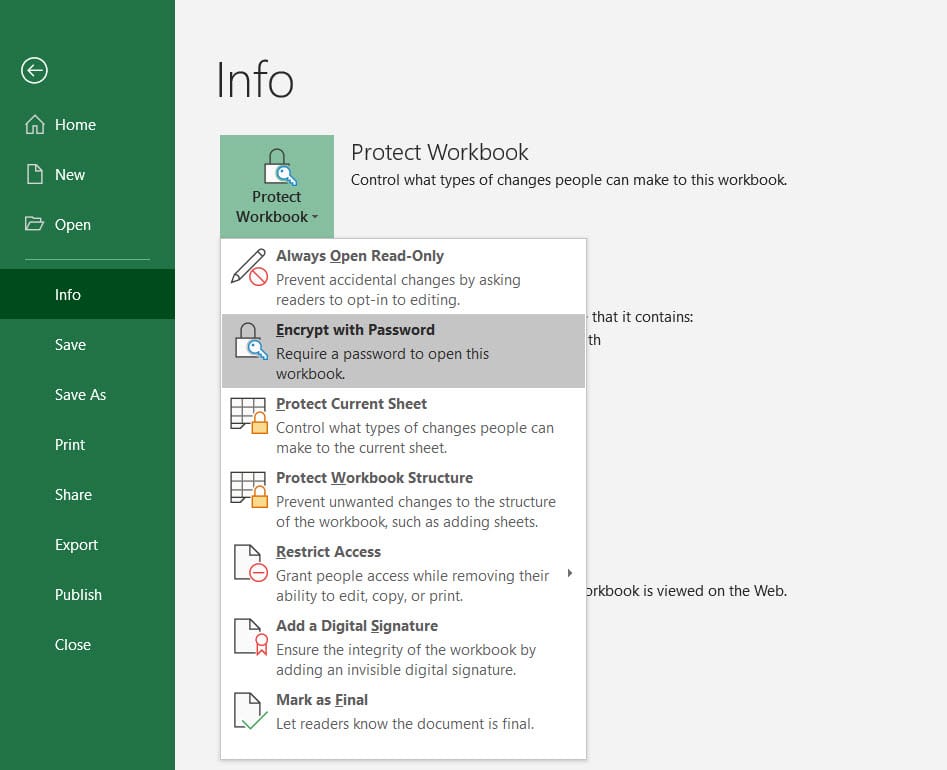5 Simple Ways to Password Protect Excel Sheets

The Microsoft Excel platform isn't just a tool for calculations and data organization; it's also a powerhouse for storing and managing confidential information. From business financial records to personal records, Excel sheets can hold sensitive data that should only be accessible to authorized individuals. That's where password protection comes into play. In this guide, we'll delve into the various methods you can use to secure your Excel sheets, ensuring your data remains in safe hands.
1. Built-in Excel Password Protection

Excel includes a native feature to safeguard your workbook or worksheets with a password. Here’s how to do it:
- Entire Workbook: To lock down the entire file, go to
File>Info, click onProtect Workbook, and chooseEncrypt with Password. You will be prompted to enter and confirm a password. Once set, every time someone attempts to open the file, they will be required to enter the password. - Individual Sheets: If you wish to protect specific sheets within the workbook, select the sheet you want to secure, navigate to
Review>Protect Sheet, and then decide on what permissions you want to allow before setting the password.
🔐 Note: Keep in mind that while Excel’s built-in password encryption provides a good level of protection, it might not be immune to all cracking attempts. For the most sensitive data, consider using additional security measures.
2. Using VBA Macros for Advanced Security

If you need more sophisticated control over who can access your Excel data, VBA (Visual Basic for Applications) macros can be a great ally:
- Open the Excel VBA editor with
Alt + F11. - Insert a new module via
Insert>Module. - Enter your code to prompt for a password upon opening the workbook. Here is a basic example:
Private Sub Workbook_Open() Dim pwd As String pwd = InputBox("Enter password", "Password Required") If pwd <> "your_password_here" Then MsgBox "Incorrect password. Workbook will now close." ActiveWorkbook.Close SaveChanges:=False End If End Sub - This code can be customized to fit your exact needs, such as adding multiple layers of password prompts or varying access levels for different users.
3. Third-Party Software Solutions

When Excel’s built-in features aren’t enough, third-party tools can offer stronger security options:
- Encryption Software: Use external programs like WinRAR or VeraCrypt to encrypt entire Excel files. These tools provide robust encryption algorithms, ensuring your data is secure even if the file is somehow accessed.
- Excel Add-Ins: Products like ASAP Utilities or XCell Secure extend Excel's functionality with password protection features that are more user-friendly and offer customizable security options.
4. Digital Signatures and Certificate-based Protection

To add an extra layer of verification to your Excel files, you can implement digital signatures:
- Obtain a digital certificate from a Certificate Authority (CA).
- In Excel, access the
Filetab >Info>Protect Workbook, then selectAdd a Digital Signature. Here, you can sign the document to verify your identity. - Use Excel’s Advanced Digital Signature Features to define permissions, including who can view or edit the file.
✒️ Note: Digital signatures not only protect data but also assure the recipient that the document has not been tampered with since it was signed.
5. Protecting Against Unauthorized Macros

Macros can be both a powerful tool and a potential security risk. Here’s how to control macro security:
- Navigate to
File>Options>Trust Center>Trust Center Settings, and then chooseMacro Settings. - Set the macro settings to disable all macros with notification or to disable all macros except digitally signed ones. This prevents the execution of unauthorized or potentially harmful macros.
In this extensive guide, we’ve covered several ways to secure your Excel files through password protection, macro control, digital signatures, and third-party solutions. Each method offers a different level of security, tailored to varying needs of privacy and data protection. Implementing these security measures can help maintain the confidentiality of your data, reduce the risk of unauthorized access, and ensure the integrity of your Excel documents.
Can I recover a forgotten Excel password?

+
If you forget your Excel password, built-in methods won't help since Excel doesn’t provide password recovery options. However, various third-party tools and password recovery software can help, but their effectiveness isn’t guaranteed.
Is VBA a secure way to protect Excel files?

+
VBA can provide an additional layer of security, but it isn't foolproof. Since VBA code can be viewed and possibly bypassed by knowledgeable users, for top-level security, it should be used in conjunction with other protection methods.
What happens if I use encryption software to protect my Excel file?

+
Encryption software like WinRAR or VeraCrypt applies an additional encryption layer to your Excel file, making it unreadable without the correct decryption key or password. This adds significant security since the file cannot be accessed even if someone bypasses Excel's native security.
In sum, safeguarding your Excel documents with password protection and other security measures helps protect sensitive information from unauthorized access. Whether you’re using Excel’s built-in features, VBA, third-party software, or digital signatures, a combination of these methods ensures comprehensive protection of your data. Always remember to use strong, unique passwords, keep them secure, and consider multiple layers of security to fortify your data against potential threats.